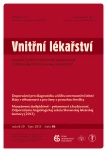Prevalence of hyponatremia in patients on department of internal medicine
Authors:
M. Rudnay; I. Lazúrová
Authors‘ workplace:
I. interná klinika Lekárskej fakulty UPJŠ a UN L. Pasteura Košice, Slovenská republika, prednostka prof. MU Dr. Ivica Lazúrová, CSc., FRCP
Published in:
Vnitř Lék 2013; 59(10): 876-879
Category:
Original Contributions
Overview
Introduction:
Hyponatremia is the most common electrolyte disorder detected by biochemical laboratories in the present time and interest about it increases because of new informations about its consequences.
Aim:
Objective of our work was to determine the prevalence of hyponatremia in patients hospitalized at clinic of internal medicine and to analyze its most common causes.
Patients and results:
The total number of hospitalized patients for a period of 6 months was 1,203. Severe hyponatremia, i.e. S‑ Na < 130 mmol/ l was detected in 83 cases, i.e. 6.9% of all patients. 14 patients, i.e. 1.15% have more severe hyponatremia with S‑ Na < 120 mmol/ l. The most common type of hyponatremia was hypervolemic hyponatremia (n = 41; 49.4%) associated with liver cirrhosis and hearth failure, less common was euvolemic hyponatremia (n = 28; 33.7%) and least common was hypovolemic hyponatremia (n = 14; 16.9%). The most common cause of euvolemic hyponatremia was syndrome of inappropriate antidiuretic hormone secretion (SIADH) and thiazide diuretics therapy. Next to thiazide diuretics, other common cause of euvolemic hyponatremia, and so SIADH, was therapy by selective serotonin reuptake inhibitors (SSRI).
Conclusion:
The authors point out, that it is necessary to control serum sodium concentration on regular base in case of long‑term therapy by thiazide diuretics or SSRI, especially in elderly patients.
Key words:
hyponatremia – SIADH – liver cirrhosis – hearth failure – thiazide diuretics
Sources
1. Kumar S, Berl T. Sodium. Lancet 1998; 352: 220– 228.
2. Sajadieh A, Binici Z, Mouridsen MR et al. Mild hyponatremia carries a poor prognosis in community subjects. Am J Med 2009; 122: 679– 686.
3. Gankam Kengne F, Andres C, Sattar L et al. Mild hyponatremia and risk of fracture in the ambulatory elderly. QJM 2008; 101: 583– 588.
4. Gill G, Huda B, Boyd A et al. Characteristics and mortality of severe hyponatraemia – a hospital‑based study. Clin Endocrinol (Oxf) 2006; 6: 246– 249.
5. Miyashita J, Shimada T, Hunter AJ et al. Impact of hyponatremia and the syndrome of inappropriate antidiuresis on mortality in elderly patients with aspiration pneumonia. J Hosp Med 2012; 7: 464– 469.
6. Zilberberg MD, Exuzides A, Spalding J et al. Hyponatremia and hospital outcomes among patients with pneumonia: a retrospective cohort study. BMC Pulm Med 2008; 8: 16.
7. Sherlock M, O’Sullivan E, Agha A et al. Incidence and pathophysiology of severe hyponatraemia in neurosurgical patients. Postgrad Med J 2009; 85: 171– 175.
8. Hannon MJ, Thompson CJ. The syndrome of inappropriate antidiuretic hormone: prevalence, causes and consequences. Eur J Endocrinol 2010; 162 (Suppl 1): S5– S12.
9. Rudnay M, Hrabčáková P, Lazúrová I. Hyponatraemia associated with the syndrome of inappropriate antidiuretic hormone hypersecretion (SIADH) – options for treatment. Vnitř Lék 2012; 58: 52– 55.
10. Guevara M, Ginès P. Hyponatremia in liver cirrhosis: pathogenesis and treatment. Endocrinol Nutr 2010; 57 (Suppl 2): 15– 21.
11. Ghali JK. Mechanisms, risks, and new treatment options for hyponatremia. Cardiology 2008; 111: 147– 157.
12. Rosner MH. Severe hyponatremia associated with the combined use of thiazide diuretics and selective serotonin reuptake inhibitors. Am J Med Sci 2004; 327: 109– 111.
13. Shapiro DS, Sonnenblick M, Galperin I et al. Severe hyponatraemia in elderly hospitalized patients: prevalence, aetiology and outcome. Intern Med J 2010; 40: 574– 580.
14. Vu T, Wong R, Hamblin PS et al. Patients presenting with severe hypotonic hyponatremia: etiological factors, assessment, and outcomes. Hosp Pract 2009; 37: 128– 136.
15. Kennedy PG, Mitchell DM, Hoffbrand BI. Severe hyponatraemia in hospital inpatients. Br Med J 1978; 2: 1251– 1253.
16. Clayton JA, Le Jeune IR, Hall IP. Severe hyponatraemia in medical in‑patients: aetiology, assessment and outcome. QJM 2006; 99: 505– 511.
17. Coenraad MJ, Meinders AE, Vandenbroucke JPet al. Causes of hyponatremia in the Departments of Internal Medicine and Neurosurgery. Eur J Intern Med 2003; 14: 302– 309.
18. Hochman I, Cabili S, Peer G. Hyponatremia in internal medicine ward patients: causes, treatment and prognosis. Isr J Med Sci 1989; 25: 73– 76.
19. Leung AA, Wright A, Pazo V et al. Risk of thiazide‑induced hyponatremia in patients with hypertension. Am J Med 2011; 124: 1064– 1072.
20. Hwang KS, Kim GH. Thiazide‑induced hyponatremia. Electrolyte Blood Press 2010; 8: 51– 57.
21. Hix JK, Silver S, Sterns RH. Diuretic‑associated hyponatremia. Semin Nephrol 2011; 31: 553– 566.
22. Seldin DW, Eknoyan G, Suki WN et al. Localization of diuretic action from the pattern of water and electrolyte excretion. Ann NY Acad Sci 1966; 139: 328– 343.
23. Heinemann HO, Demartini FE, Laragh JH. The effect of chlorothiazide on renal excretion of electrolytes and free water. Am J Med 1959; 26: 853– 861.
24. Chow KM, Szeto CC, Wong TY et al. Risk factors for thiazide‑induced hyponatraemia. QJM 2003; 96: 911– 917.
25. Clayton JA, Rodgers S, Blakey J et al. Thiazide diuretic prescription and electrolyte abnormalities in primary care. Br J Clin Pharmacol 2006; 61: 87– 95.
26. Wright SK, Schroeter S. Hyponatremia as a complication of selective serotonin reuptake inhibitors. J Am Acad Nurse Pract 2008; 20: 47– 51.
27. Letmaier M, Painold A, Holl AK et al. Hyponatraemia during psychopharmacological treatment: results of a drug surveillance programme. Int J Neuropsychopharmacol 2012; 15: 739– 748.
Labels
Diabetology Endocrinology Internal medicineArticle was published in
Internal Medicine

2013 Issue 10
Most read in this issue
- Methods of skin microcirculation assessment
- Tricuspid valve infective endocarditis in intravenous drug abuser
- The current approach to the treatment of the patients with metastatic colorectal cancer
- Management of dyslipidaemias – present and future. Guidelines of the Angiology Section of the Slovak Medical Chamber (2013)
